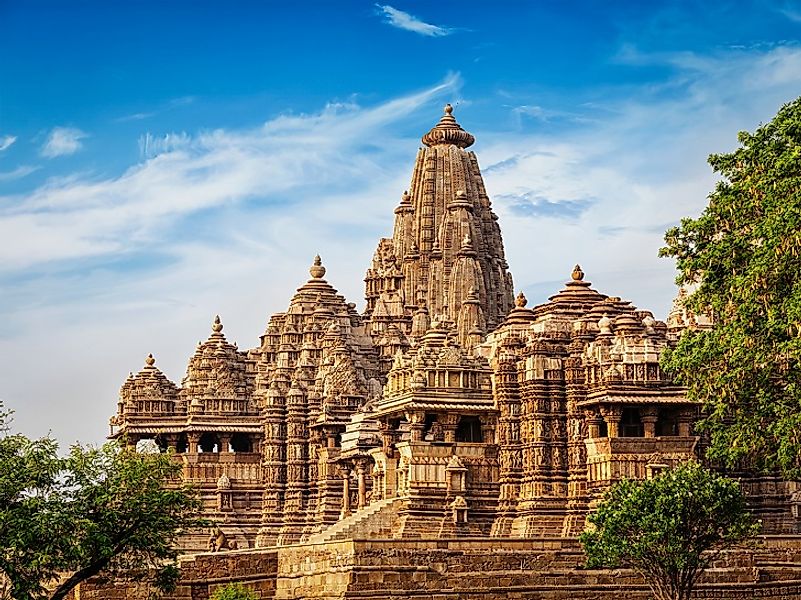Where Are The Khajuraho Temples Of Love?

5. History and Construction
The Khajuraho group of monuments, declared a UNESCO World Heritage Site, are located near the town of Khajuraho in the Chhatarpur district of Madhya Pradesh in India, around 620 kilometers southeast of the capital city of India, New Delhi. The Khajuraho monuments, famous for their erotic sculptures and religious significance, draw thousands of tourists from all across the globe to visit this place every single year. The Khajuraho monuments were built over a period of 100 years from 950 to 1050 during the rule of the Hindu dynasty of the Chandela Rajputs of India. Most of the temples of the complex were built during the rule of the Chandela Kings Yashovarman and Dhanga. King Ganda built the largest and the most impressive of the Khajuraho temples, which is named the Kandariya Mahadeva, during his reign between 1017-1029 CE. In the 13th Century, with the demise of the Chandela Dynasty at the hands of the army of the Delhi Sultanate led by Muslim Sultan Qutb-ud-din Aibak, the importance of the Khajuraho temples waned ever lower. Fortunately, due to the remoteness of the temples of Khajuraho, the buildings were spared from being totally destroyed by the invading Muslim armies, who set out on a destructive spree to demolish many such Hindu and Jain temples during the same period. The temples were left in neglect until they were rediscovered in the 19th Century by the British surveyor T.S. Burt, who was led to the temples' sites by local Hindus. More than 80 temples initially were constructed, though around only 20 survive into the present day.
4. Architecture
The architecture of the Khajuraho temples and other monuments is influenced heavily by Hindu and Jain architectural styles and beliefs. The settings of the temple complex, with monuments scattered amidst the hilly landscape, itself crisscrossed by rivers, lends an aesthetic beauty to the entire area. The temples were built of sandstone with a granite foundation, employing innovative techniques and requiring highly skilled artisans to complete the task. Typical of Hindu temples, the temples of Khajuraho are mostly located near water bodies including ponds, lakes, and rivers, with the main entrances to these shrines facing the direction of the sunrise in the east. These temple grounds were usually laid out in the form of 3 triangles converging to form a pentagon, representing the three realms and five cosmic substances of Hinduism, and following the grid geometrical design subscribed by Hindu architecture. The basic design of the temples involves the sacred chamber, or the garbhagriha (in which the supreme deity worshipped in the temple is believe to reside), with a shikhara (a form of spire) rising above the garbhagriha. The temples spread out into a symmetric pattern of self-repeating structures from the cores of the temples (the garbhagrihas).
3. Erotic Art
The temples of Khajuraho depict spectacular artwork in the form of sculptures on both the interior and exterior walls of these temples. 10% of these sculptures depict erotic acts being carried out by human beings. These erotic carvings are usually avoided in the walls facing the deities of the temples, which could imply that sexual desires need to discarded while entering the temple to worship the same deity. The presence of the erotic art among the other art forms depicting the daily life of the Hindus of the region during the time when the temples were built could be representative of the Hindu tradition of treating kama, or sexual desires, as a part of everyday human life. Some scholars also suggest that the erotic sculptures of the temples represent tantric sexual practices, which are important in Buddhist beliefs as well.
2. Religious Significance
The entire collection of art and architecture of the Khajuraho temples attempts to highlight the central ideas of Hinduism, including the Hindu principles of dharma, karma, artha and moksha, and the interdependence between masculine and feminine entities. Some of the major Gods and Goddesses of Hinduism, as well as the Jain tirthankaras, have temples dedicated to them in the Khajuraho temple complex. The sculptures on the walls of the temples also depict the traditional Hindu ways of life, acting as a lifestyle guides to practicing Hindus. Only a few of the temples of Khajuraho remain active for religious purposes, and these include the Matangeshvara temple and the Kandariya Mahadev temple.
1. Threats and Preservation
The Khajuraho monuments have survived thousands of years of threats to their integrity and structure, and currently serve as a tourist hot spot for all of India, and an archaeological wonder of South Asia. In the early years of the 21st Century, there were reports of cracks developing in the temple structures due to vibrations triggered by low-flying aircrafts over Khajuraho. This was followed by widespread protests by environmentalists and local residents of Khajuraho. Presently, the economic importance of the temple complex to the local and state economy encourages its protection by the Government of Madhya Pradesh, and thus the centuries-old Khajuraho monuments continue to survive into the modern 21st Century.







